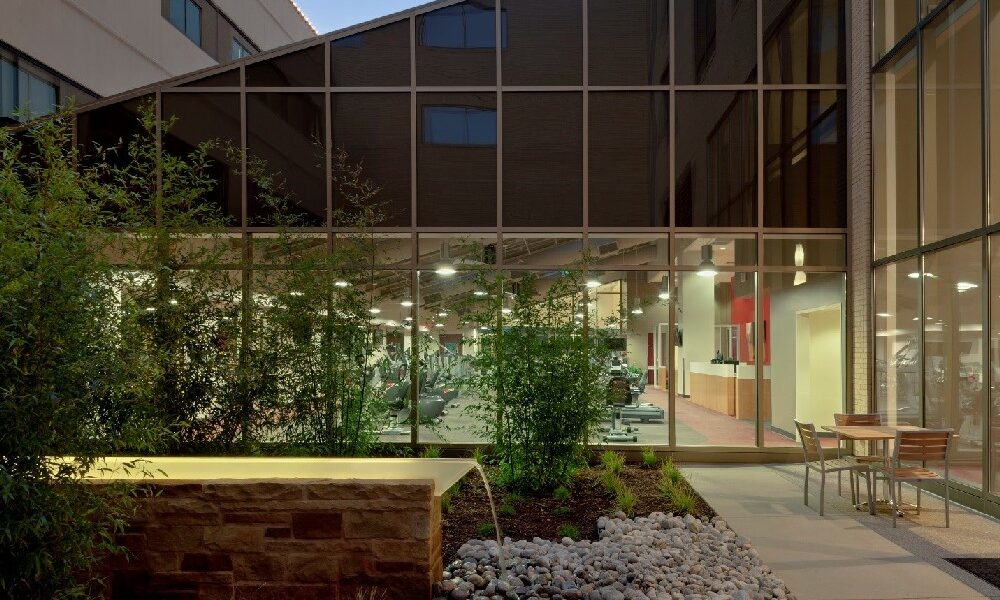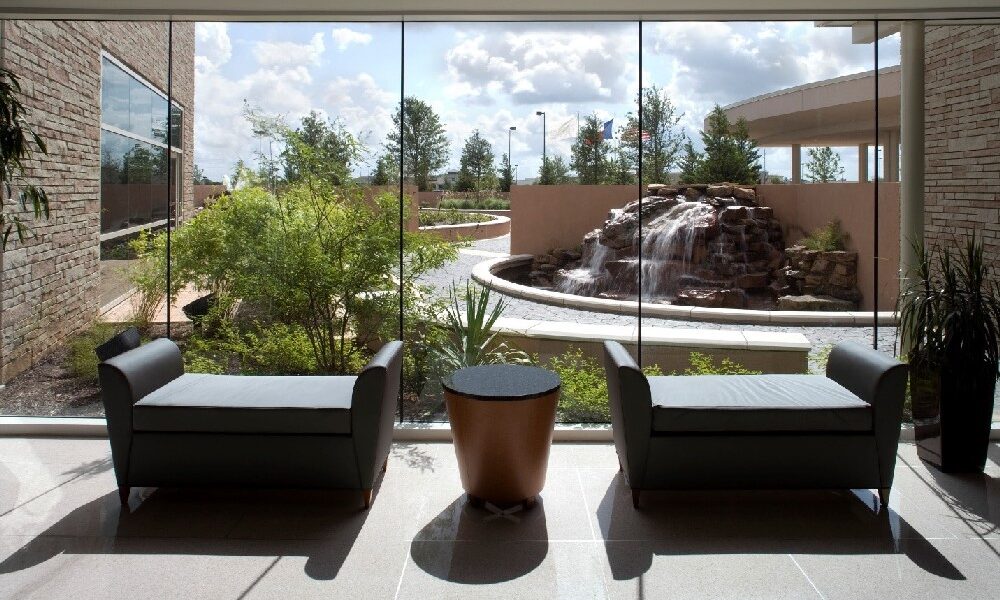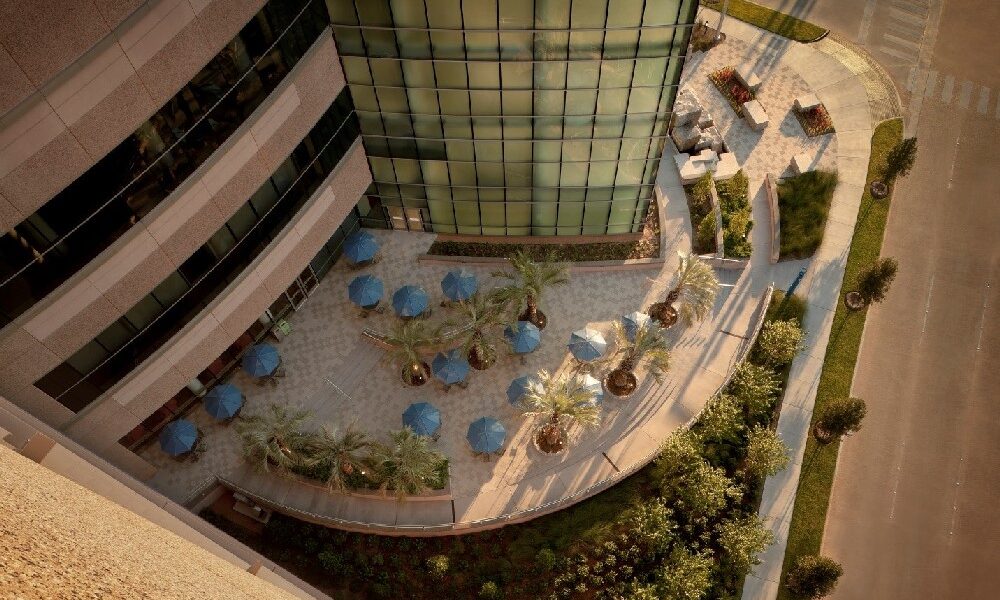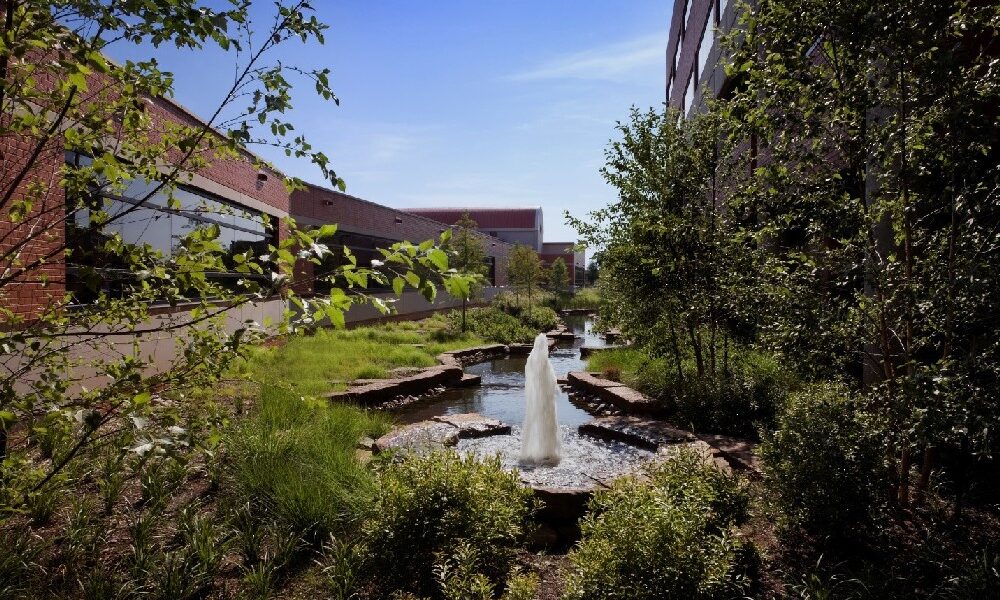 CHRISTUS Trinity Mother Frances Louis and Peaches Owen Heart Hospital courtyard is a relaxing respite space where water falls onto stones, and greenery provides a natural window screen. Photographer - Aker Imaging
CHRISTUS Trinity Mother Frances Louis and Peaches Owen Heart Hospital courtyard is a relaxing respite space where water falls onto stones, and greenery provides a natural window screen. Photographer - Aker Imaging  Memorial Hermann Sugar Land Hospital has large windows that let in natural daylight and allow for scenic views of greenery, waterfalls, trees and sky. Photographer - Aker Imaging
Memorial Hermann Sugar Land Hospital has large windows that let in natural daylight and allow for scenic views of greenery, waterfalls, trees and sky. Photographer - Aker Imaging  This open-tiled terrace with attractive greenery, umbrella tables and tiered landscaping is adjacent to a parking garage and medical building at University of Texas MD Anderson Cancer Center, providing a shady spot to wait or have lunch. Photographer - Aker Imaging
This open-tiled terrace with attractive greenery, umbrella tables and tiered landscaping is adjacent to a parking garage and medical building at University of Texas MD Anderson Cancer Center, providing a shady spot to wait or have lunch. Photographer - Aker Imaging  A relaxing landscape with a prominent water feature provides serene views from large windows in the Comanche County Memorial Hospital Leah Fitch Cancer Center in Southwest Oklahoma. Photographer - Aker Zvonkovic Photography
A relaxing landscape with a prominent water feature provides serene views from large windows in the Comanche County Memorial Hospital Leah Fitch Cancer Center in Southwest Oklahoma. Photographer - Aker Zvonkovic Photography Subscribe Now
Green Healing for All through Landscape Planning, Design
By Jessica Petro and Ricardo De Leon
Thoughtful landscape design and planned green space at healthcare facilities can directly contribute to the patient’s healing process, but it can also reduce stigma, improve wayfinding and increase community acceptance. And when landscaping and greenery has a measurable impact, it becomes inarguably worth the investment.
Green healing
A mountain of research points to integrating nature as a healing element in healthcare environments. One of the most well-known findings was Roger Ulrich’s 1984 discovery that hospitalized surgical patients with a view of a brick wall did far less well in recovery than patients with a view of trees, on measures including length of stay, pain medication use and positive nurses’ notes. A shorter recovery, less pain medications and more positive interactions with staff weren’t just lofty ideals, but tangible improvements that would impact patient and staff satisfaction and the hospital’s bottom line.
With landscape design, we try to think of all aspects of the needs of patients and visitors. In addition to accessibility for people with walkers, wheelchairs or mobility/balance issues, there are times when designs need to be adjusted to better meet people’s underlying conditions, as well. For example, for patients with compromised immune systems, considerations of water features and their placement — the location, frequency and types of seating and even the type of mulch that is used — can be vital to safeguarding health and safety.
Contributing to the community
It also helps to consider the community’s needs in the design. Does the community need places for people to walk safely, to hold community meetings or take part in outdoor activities? An open space for children to play in a park-like setting?
Initially, we think a lot about site context and the immediate healthcare campus. If this is a new building, designers and landscape architects start at a macrolevel and try to understand how best to connect it to its community, such as looking at transit access and the types of patients being served. Then we consider the concept of a “front door,” creating a welcoming environment for anyone, whether they are joyous or anxious.
For example, in determining a good site to build a behavioral health facility in Houston, Texas, we first mapped the city and looked at areas most in need considering economics and mental health issues. The place we identified was an abandoned hospital in the center of a community. We began exploring design strategies, including those that help reduce the stigma of mental health treatment. Much of that can be done with landscaping, greenspace and connecting the site to the people who live in the community. Rather than the facility being imposed on the community, it’s a beautiful, walkable environment that those who pass by can incorporate into their lives and take pride in.
The goal is to create a porous environment with a care model that is open and inviting. The more you connect a space with greenery, gardens, beauty and relaxation, the less institutional it will seem. This reduces stigma and makes the facility a positive addition.
Designing thoughtful opportunities for a seamless integration with the neighborhood, such as trails or gardens that allow passersby to experience the outer campus, also helps reduce the stigma of behavioral health facilities. If the facility requires a private entrance, you can provide patient access through a scenic courtyard or walkway ending at a secure entrance.
The next thing to look at are site systems, such as the natural vegetation, topography, drainage and soils. These natural systems help inform the climates and microclimates. We strive to give the space regional context, as well as to understand the client’s needs and values, weaving those elements together to come up with meaningful spaces appropriate to the facility’s location and mission.
Through these steps, we gain buy-in and positive engagement. Town halls, community tours and educational workshops can bolster this engagement and create a favorable relationship.
Landscaping as wayfinding
Aligning landscape design with wayfinding and circulation means there is a safe, intuitive way to navigate through the campus and facility. Predesign and early concept meetings with the client help us start formulating spaces. Mapping helps us understand how to connect the site to other main points through the implementation of green spaces. Also, specific landscape elements can be unique in such a way that they act as wayfinding elements in and of themselves, which is helpful on large or labyrinthine medical campuses.
Distinctive plant palettes, a water feature or a sculpture that is easily identifiable helps move people through and around the facility by serving as directional guides or landmarks. These spaces can also be donor opportunities, whether naming a garden, providing a scenic spot for a donor naming wall or allowing for a meaningful connection between landscape and campus mission, such as a therapeutic or educational garden.
In addition to outside spaces, there might be interior spaces like pocket courtyard gardens dedicated for staff or patients and other opportunities for the landscape to be pulled throughout the facility, as well as to enhance views from the inside. Remember to include landscaping and greenery in and around parking lots or decks; since many parking decks connect healthcare buildings, they present a ripe opportunity for plazas, terraces, tiered gardens or natural courtyards in these connector spaces.
Streetscapes can create a buffer for pedestrians, protecting them from traffic, while creating safe and attractive paths that can accommodate community members, as well as patients and families. And outdoor waiting spaces allow for private, shaded niches where visitors, staff and patients can sit in a tranquil, calming environment and children can play on grassy areas beneath the trees.
Respect the seasons
While in the past we’ve thought of hospitals as having manicured, high-maintenance landscaping, that is changing. An increasing awareness of climate change means trying to conserve resources by working with nature to reduce water use. Hopefully, this will start to update the concept of what beauty is and what healthy landscapes can look like.
Some clients want manicured gardens that are ever blooming or layered in such a way that whatever the season, there are beautiful vistas. But, let’s say in New England, during the colder parts of the year, landscape architects don’t have that option. Winter landscapes can still be restorative and peaceful, it’s just a different approach — such as planting trees with exfoliating bark or that produce different colors against the snow. This still imparts the sense of an organized garden, and it’s not too stark or solemn, allowing us to explore a healing space that celebrates all seasons in a naturalized setting for a hospital.
For behavioral health, the intent of a courtyard is to provide a secure space for patients who can enjoy the outdoors without being surrounded by fencing and barbed wire. The courtyard can have multiple private spaces or a more communal space, so there is choice within the circulation. Patients who want to be on their own can be out enjoying the sun, but they don’t have to be around other people. We can create that visual separation by selecting vegetation that provides privacy. And fountain noises can be comforting — we just have to make sure the fountain is designed so it isn’t a hazard.
When landscape is integrated as part of the healing process, and landscape designers are brought in as team members early in the process of designing healthcare facilities, we can have strategic discussions about the various roles natural areas and elements can play within a healthcare campus.
Author: Jessica Petro and Ricardo De Leon
Jessica Petro, PLA, ASLA, SITES AP, is a landscape architect at Page. Ricardo De Leon is an architectural designer with Page.
Tags: Green Building, landscape design, landscape planning, Page, Wayfinding
Posted May 17, 2023
More Articles:
- CxA Workshop & Exam
Apr 29, 2024 – Apr 30, 2024 - EMP Seminar & Exam at CxEnergy 2024
Apr 29, 2024 – Apr 30, 2024 - CxEnergy
Apr 29, 2024 – May 2, 2024 - PHCC West 2024
Apr 29, 2024 – May 2, 2024 - Lean in Design Forum 2024
May 1, 2024 – May 2, 2024 - IFMA’s Facility Fusion Conference & Expo
May 5, 2024 – May 7, 2024 - ASHE Academy 2024
May 6, 2024 – May 10, 2024










